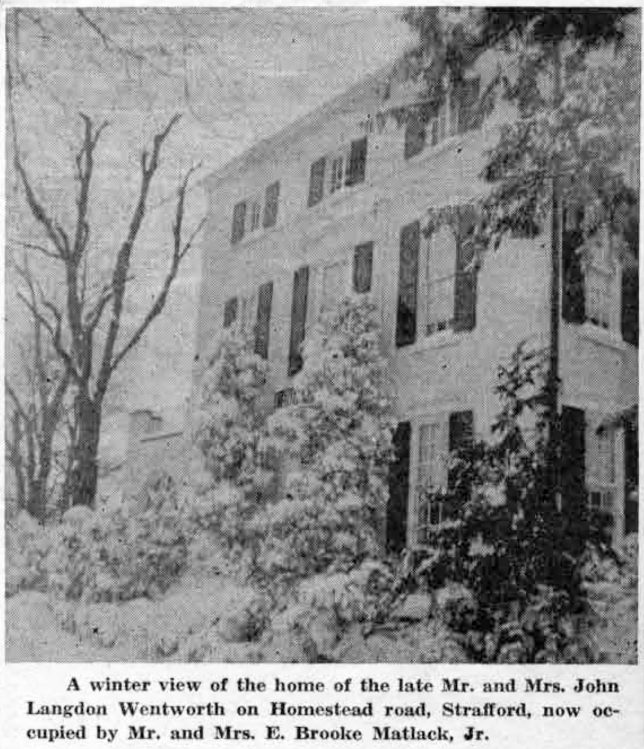 As told in this column last week, it was in this house that Martha Wentworth, now Mrs. Charles E. Suffren, was born on October 10, 1858. Mrs. Suffren still lives on Homestead Road, in a house on the property adjacent to her birthplace. Like the former, it is a handsome while edifice which was built by Mr. and Mrs. Suffren in 1908-09. Later they sold it when they went to New York state to live. However, when they returned to permanent residency in Strafford in 1920, they were fortunate enough to regain possession of their former home. Standing on an acre and a half of ground which is part of the 130 acres bought by Mrs. Suffren’s parents now almost a hundred years ago, it is the only part of the original large tract still in the possession of any member of the Wentworth family.
As told in this column last week, it was in this house that Martha Wentworth, now Mrs. Charles E. Suffren, was born on October 10, 1858. Mrs. Suffren still lives on Homestead Road, in a house on the property adjacent to her birthplace. Like the former, it is a handsome while edifice which was built by Mr. and Mrs. Suffren in 1908-09. Later they sold it when they went to New York state to live. However, when they returned to permanent residency in Strafford in 1920, they were fortunate enough to regain possession of their former home. Standing on an acre and a half of ground which is part of the 130 acres bought by Mrs. Suffren’s parents now almost a hundred years ago, it is the only part of the original large tract still in the possession of any member of the Wentworth family.
It is here that Mrs. Suffren lives with her companion, and it is here that her daughter, her grandchildren and her great-grandchildren come to visit her from time to time. The wide front door leads from the porch into a large square hallway, flanked on one side by the charming living room and on the other by a large dining room. A wide stairway leads to the upper stories which contain seven bedrooms and four baths. All windows look out onto a sweep of well kept lawn with trees on every side, many of them antedating Mr. Wentworth’s purchase of his 130 acres.
Mrs. Suffren, a delightful person with a keen sense of humor, still takes an active part in the management of her home. She enjoys its surrounding grounds even to picking up the fallen apples in the autumn just as she did when a little girl. Up until a few years ago she even did her own marketing.
Many of the small happenings in the quiet but happy childhood of this remarkable woman were told in last week’s column. But the memory of a day in the spring of 1865 was one of such outstanding tragedy throughout the nation that its sorrow touched even the little six and a half year old girl. In the 90 years and more that have passed since April 15, 1865, Mrs. Suffren has never forgotten the sorrow that was of such nationwide significance that it reached even into her quiet country home, affecting the lives of all who were there. For it was on the evening of that day that John Wilkes Booth shot president Abraham Lincoln from the back of the presidential box in the Ford Theater in Washington.
The next morning Lincoln died. And it was then that the Wentworth family heard the sad news from the lips of Dr Henry Pleasants, their family physician, who had stopped by on his horse and buggy round to tell them. Mrs. Suffren still remembers the scene in the big front hall and can visualize where each one sat and stood. Her mother’s tears as she sat on the bottom step were the first that the small Martha, standing just behind on the stairs, had ever seen her shed. The entire household assembled there had been praying for Lincoln’s recovery, as had their fellow countrymen across the nation.
A few days later, neighbors from far and near gathered with the Wentworth family on the front lawn to watch the Lincoln funeral train as it made its slow and solemn way from Washington to Springfield, Ill., where Lincoln was laid to rest in Oak Ridge Cemetery. In her mind’s eye Martha Suffren can still see that train as she saw it coming slowly into view along the railroad tracks in front or her home. One soldier stood at the head of the casket and another at the foot in the railroad car with its sides made of glass so that the casket might be visible to all onlookers along the railroad right of way. The group of Wentworth friends and neighbors stood in silence as the train passed out of sight. That was 90 years ago in April of this year.
On the high white columns of their stately home, the Wentorth family had draped two large black shawls. Small Martha thought they looked very beautiful and wished that her father might leave them there. And as with everything else that touched the life of that small girl in the tragic death of Lincoln, Mrs. Suffren can still visualize those black shawls on the tall white pillars of her home.
(To be continued)
